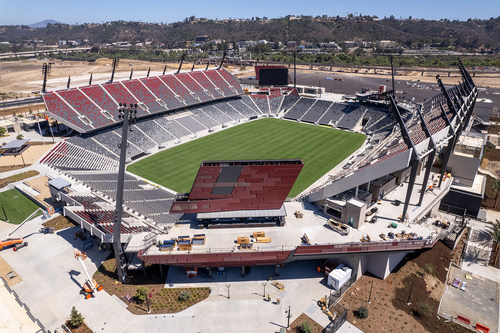Construction of the Snapdragon Stadium at the San Diego State University has been completed and opened to the public.
A high-performing team of more than 250 firms, including engineers, and trade contractors put together the state-of-the-art facility. The team was led by Clark Construction Group one of the nation’s most experienced and respected providers of construction services.
Throughout the project’s construction, Clark assisted in running training sessions to make sure a local and diverse workforce got the chance to work on it. The primary architect was Gensler Sports.
The development phase of the Snapdragon Stadium
Snapdragon Stadium is the result of a two-year, rigorous construction process. Approximately 4,000 people put in a total of 1.2 million hours. Reportedly, Clark destroyed Qualcomm Stadium to create room for the new facility. Qualcomm was the longtime home of the San Diego Chargers.
The structure was constructed using a mix of cast-in-place concrete, precast concrete, and steel. Additionally, Crews lifted the ground by approximately 30 feet. This allowed them to place 2,500 steel beams to form the stadium.
Also Read: San Diego’s Plans for US$ 24M PATH Villas El Cerrito Project, California
“Construction is a team sport, as evidenced by this project. We were able to produce a top-notch facility for SDSU and the larger San Diego community. Moreover, the project completion was on time and below budget. This is mainly because everyone focused on winning together “said Albert Valdivia. Valdivia is the vice president of Clark responsible for the project’s construction operations.
Features and expectations for the stadium
The new 35,000-capacity Snapdragon Stadium is created as a center for sports and entertainment. Therefore, it will serve as the home field for the SDSU Aztec Football team. In addition, the facility will host professional and collegiate soccer, NCAA finals, concerts, and other cultural events.
Noteworthy, the stadium is a part of SDSU Mission Valley’s first phase. This phase is a mixed-use, medium-density, transit-oriented development. It will reportedly increase the university’s academic, research, entrepreneurial, and technological offerings. SDSU Mission Valley will eventually feature housing, shopping, and the creation of public open spaces and parks.
Up to 15,000 more students could have access to education thanks to an innovation district. Furthermore, it is anticipated to increase the university’s annual economic impact on the local economy by about $3 billion.

